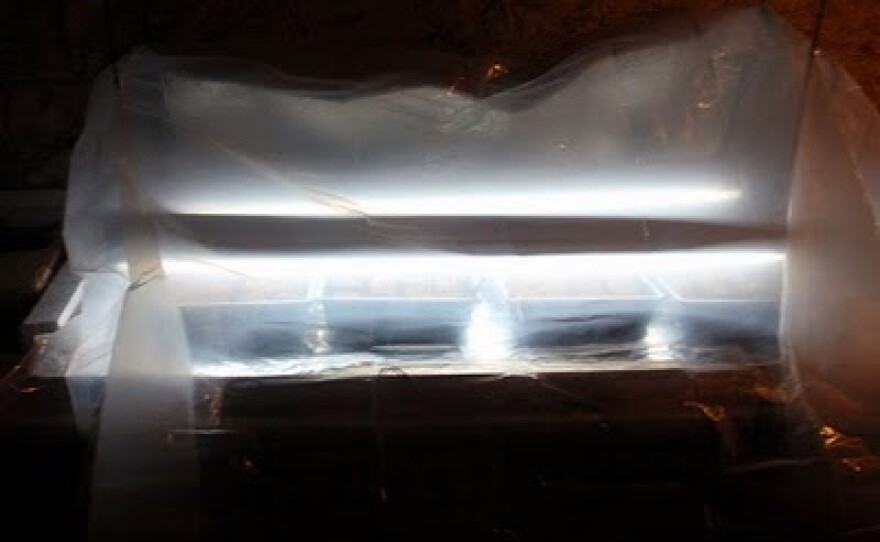To complement our weekend programming, in this new bi-weekly column I'll write about the trials and tribulations of my own gardening and that of others, including community gardeners as they work to establish a new space to grow. I hope you get inspired to dig in the dirt yourself. With temperatures on the rise, now is the time to start seeds indoors and get ready to experience the superior flavor of vegetables you can grow at home in your own back yard. Here's one way to get started.
Seed Selection
One of the joys of being a gardener is getting all the seed catalogs in the mail during the icy winter months, pouring over hundreds of photos of brightly colored, unusual vegetable varietals, and dreaming of bountiful yields to grace your plate from spring through fall. Heirloom seeds will provide unusual colors, shapes, and flavors.
From a friend I was given a beautiful ear of corn she grew that came from a plant that had been blessed by a Hopi elder last year. The kernels are astoundingly pearlescent and multicolored (photo above). If you have a group of friends interested in gardening, you can save your seeds each year and exchange them with one another. An annual seed swap party is a fun way to find vegetables that performed well in your area in years past and that your friends thought tasted good enough to save!
One of the most popular commercial heirloom seed suppliers, Baker Creek, is actually headquartered in southern Missouri. Oprah recently caught on to them and consequently they're experiencing more sales volume than ever before, which is great for the company and Missouri but not so great if you're a gardener who had your heart set on the now sold-out "sanguine ameliore" lettuce, "Batavian full heart" endive, or the "pimiento de Padron" hot pepper.
If you haven't already purchased your seeds, however, there's still time to get some interesting varieties from your local nursery. You can always start with purchased plants later but seeds will be much less expensive, with a pack of 300 heirlooms averaging about $2.50. If you've never started seeds on your own, setting up the equipment can be daunting and a bit pricey but once you start harvesting, and in springtimes to come, you will be happy you made the investment.
The Soil Blocking Method
For seed starting I use a soil blocker (pictured) in lieu of plastic or peat pots. A good soil blocker should last for decades and is easy, and even fun, to use. A blocker is an ejection mold used to make multiple cubes of soil at once. A major benefit to using blocks instead of pots is that there's more air circulation and your plants won't get root bound.
To make your blocks, let the soil soak up water a day ahead of planting. A coconut coir-based planting medium is a more sustainable option than peat. It's also usually a good idea to soak your seeds first as well, unless they're very small. Nicking the outer layer of the seed casing is helpful as well, some seeds won't germinate without this step. If you are planting beans, you will want to inoculate them first.
When you're ready to plant:
- Stamp your blocker into the soil;
- Release the blocks carefully into your planting tray;
- Arrange the blocks so that there's space between each for air flow;
- Repeat until your tray is full;
- Place one seed in the indentation at the top of each block, and cover with soil;
- Label the tray so you know where you planted which seeds.
Certain plants, such as carrots, grow better if their seeds are directly sown into the ground, so be sure to read the back of your seed packets for instructions regarding the best planting method and timing.
Lighting
Getting a reusable lighting setup to start enough plants to fill a garden can be very expensive, with pre-fabricated sets costing hundreds of dollars. However, it's not too difficult to make your own setup with a trip to the hardware store and a little handiwork.
- Get ordinary florescent light fixtures, but use special grow-light bulbs found at nurseries.
- Use a table or waist-high surface for the trays to sit on.
- Suspend the light fixtures from chains hooked to the ceiling or similar sturdy overhead structure. It's important to keep the lights very close to the soil blocks; the chains allow for moving the lights up as the seedlings grow.
- A timer for the lights is a convenient option.
- A heating coil or pads, designed specifically for seed starting, placed under your trays will encourage germination.
Growing
Soil blocks need to be monitored closely for watering. I watered mine every other day last year, but your conditions may vary. Water with a gentle stream, otherwise your blocks may crumble. Air flow and humidity are other important considerations. I put plastic sheeting over my lights to make an incubator and left some gaps for air.
Waiting and watching the sprouts emerge is a joyful experience. Plant your blocks directly into the garden once true leaves emerge (the initial "leaves" are called "cotyledons") and the danger of frost has passed. If the days are warm enough, it's a good practice to harden off the plants by putting them out for increasing increments of time each day in a spot sheltered from strong wind and direct sun.
If you have a child who is dramatically opposed to eating vegetables, growing your own together is a sure way to make those carrots and peas outshine even the rarest of animal crackers. And the worms in the garden, or in your composting worm bin, will delight. I'll get to that in the coming weeks, here on stlpublicradio.org.







